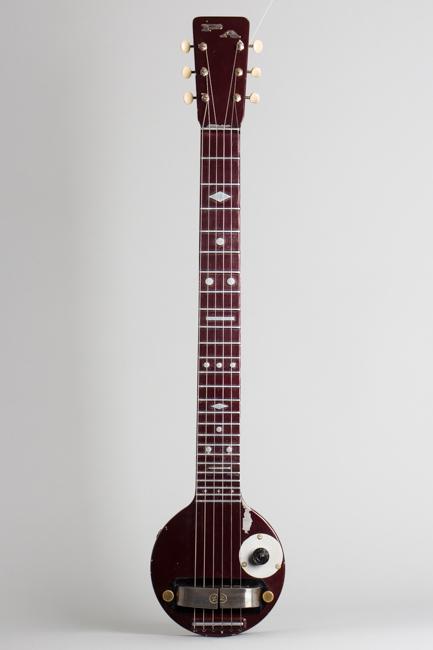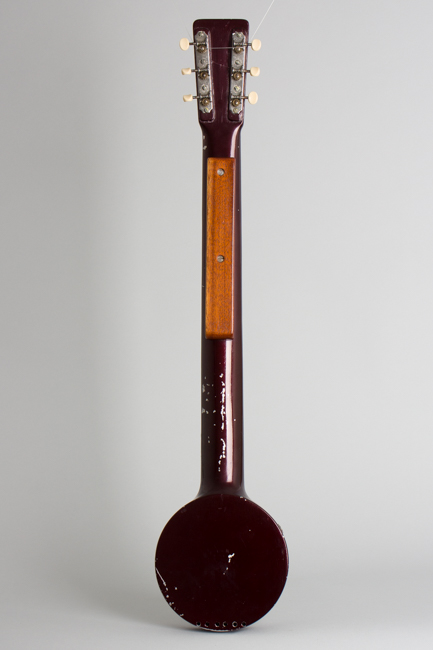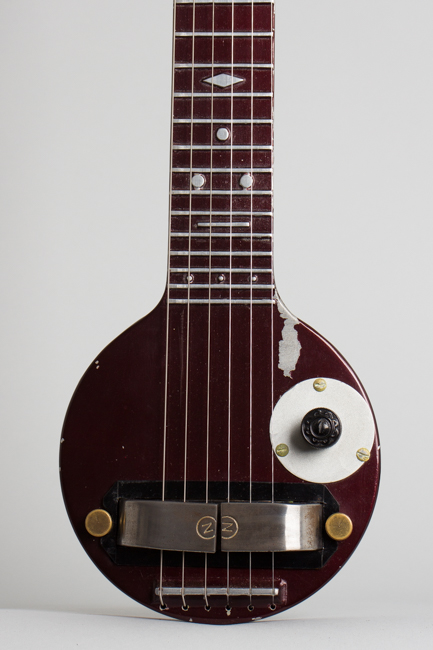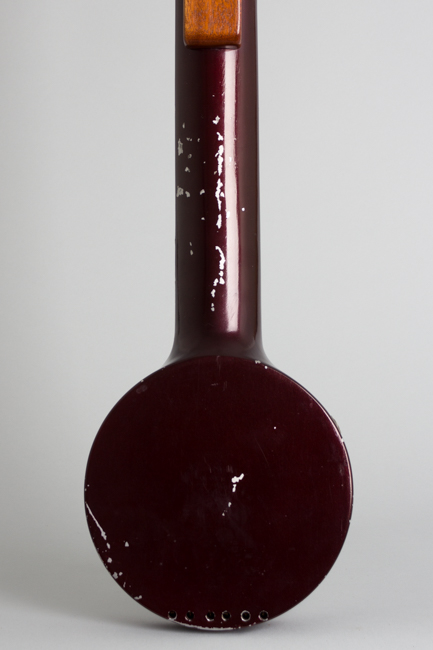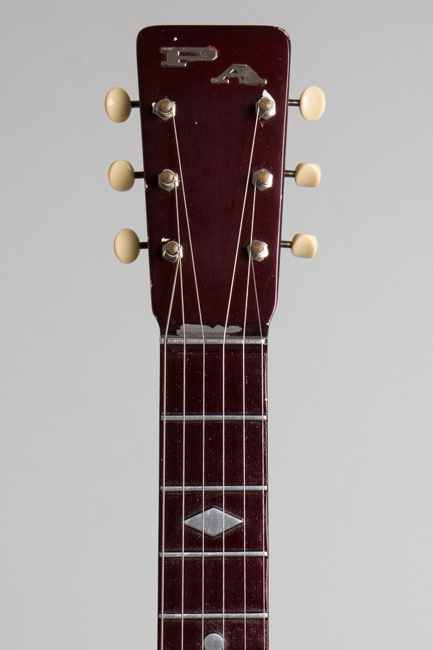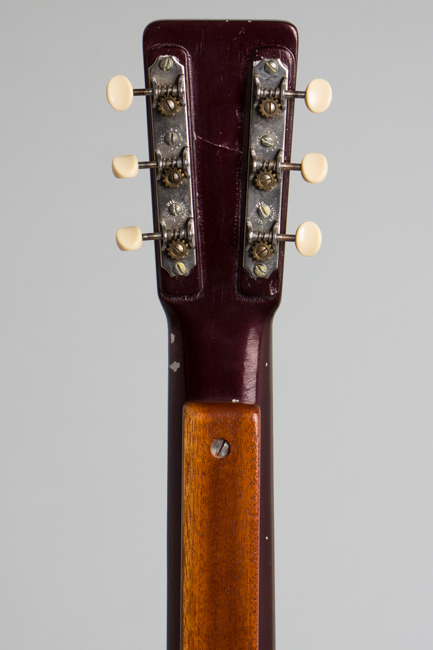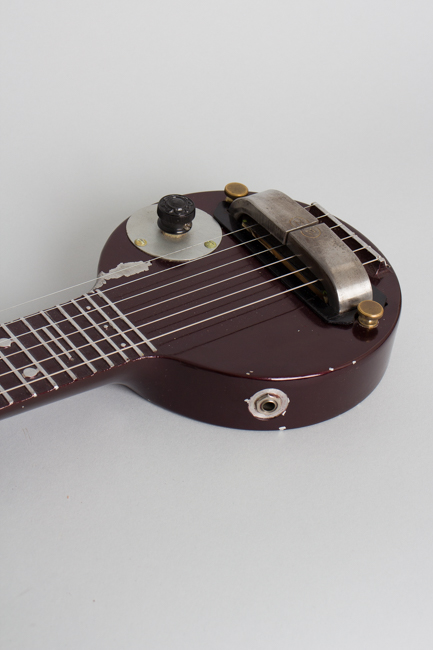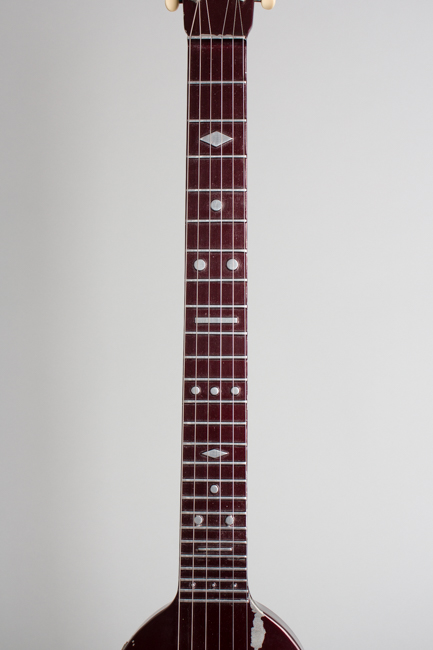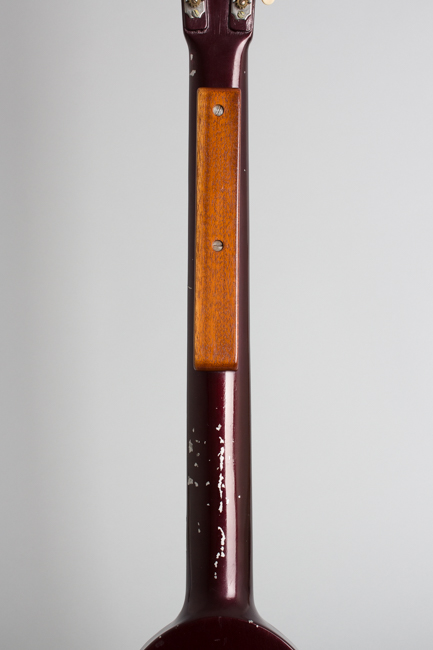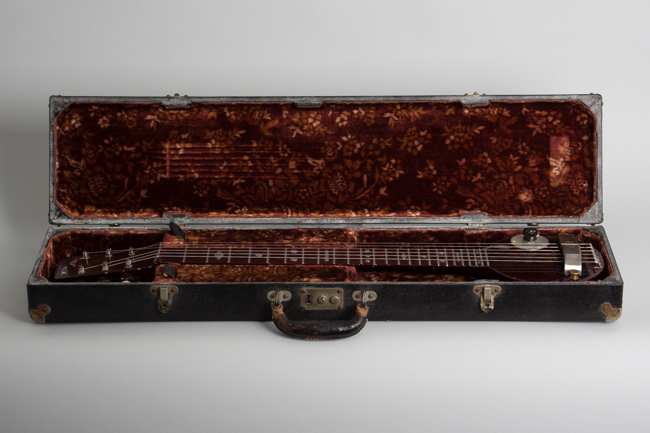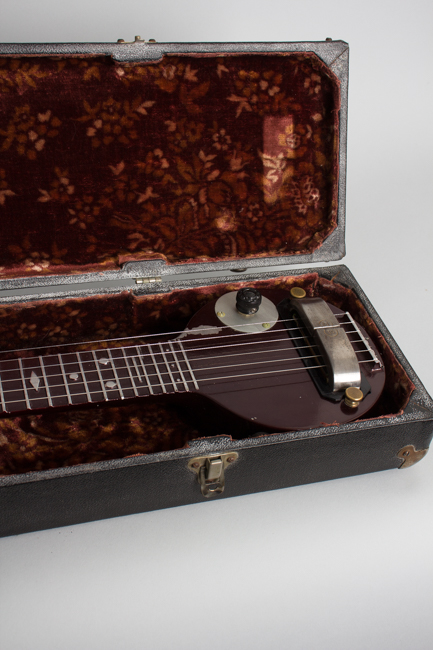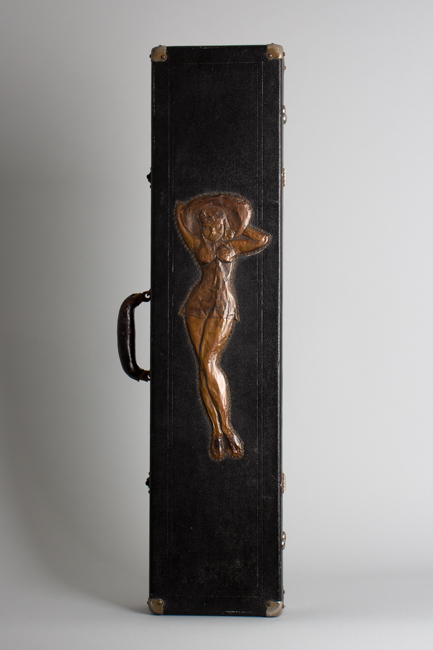Bigsby Hand Made By P.A. Bigsby Lap Steel Electric Guitar (1943)
This item has been sold.
Item # 11218
Prices subject to change without notice.
Bigsby Hand Made By P.A. Bigsby Model Lap Steel Electric Guitar (1943), made in Downey, CA, red enamel finish, one-piece aluminum body and neck, original black hard shell case.
Despite its unassuming appearance this is one of the most interesting and historically important pieces we have handled, the first musical instrument ever made by Paul "P.A" Bigsby. Bigsby is most remembered now for his namesake vibrato tailpiece, but the former motorcycle builder created the first modern solidbody electric guitar for Merle Travis in 1948, greatly influenced Les Paul and Leo Fender and essentially invented the modern pedal steel. He eschewed mass production, crafting his exceptional instruments one ty a time one at a time in a small backyard shop in the Los Angeles suburb of Downey.
This small cast aluminum steel guitar is the seed of all future Bigsby instruments, created out of necessity for himself in 1943. Bigsby had taken an interest in the steel guitar, but couldn't find a Rickenbacker A-22 like his teacher had. It was the middle of WWII;, all electrics were out of production and the aluminum that guitar was cast from was unobtainable on the civilian market.
P. A. Bigsby had a way around that. As the pattern maker/parts fabricator at Crocker Motorcycles in Los Angeles. he had access the critical material. The government restricted aluminum use but Crocker was making airplane parts for Douglas. Bigsby carved the guitar's body, neck and headstock out of wood,. making a pattern for the mold to cast in aluminum. The resulting one-piece instrument resembles the Rickenbacker with a small, round body, integral neck and solid headstock more reminiscent of a Martin. He fashioned a Rickenbacker-like horseshoe magnet pickup from scavenged materials, winding the coil and probably bending the magnets by hand. The single volume knob has an on/off function, probably from a radio. He finished the instrument with the deep red metallic paint Crocker used for its motorcycle tanks. Soon after Bigsby may have discovered that the ergonomics weren't ideal, so added a wood strip to the back of the neck for better balance on the lap.
Bigsby marked his personal steel with silver letters "P. A." on the headstock. The real telltale sign of his creation is more subtle: the fretboard has a unique pattern of dot and diamond markers Bigsby would maintain on all future instruments. He also crafted a beautifully made small rectangular case with a unique hand-hammered copper design of a 1940s Cowgirl bathing beauty on the lid.
In 1944, Bigsby attended a Spade Cooley show and showed their hugely influential steel player Joaquin Murphy the guitar he'd made. Murphy was initially dismissive but after playing it was impressed enough to commission Bigsby to build him a steel with two eight-string necks, which P.A. delivered later that year This had the same fretboard and headstock design but adding two more tuners at the top of each headstock. When other players saw Murphy's instrument they approached Bigsby with custom requests; one was Merle Travis, who in 1948 showed Bigsby a sketch of what he wanted: a solidbody electric guitar. The instrument Bigsby created for him set the pattern for both Leo Fenders Broadcaster/Telecaster and the Les Paul Gibson would produce. A steel guitar with pitch-changing pedals he crafted for Speedy West in 1948 became the inspiration for al, future pedal steels. In a few years, Bigsby had gone from a motorcycle fabricator to the progenitor of modern electric guitars.
Years later, Bigsby told the story of making that first guitar to a local LA newspaper, but no photographs of it existed and its fate was unknown. He died in 1968, having sold his business a few years earlier. This long-lost primal guitar re-appeared unexpectedly 5 decades later, in the possession of a woman unaware of its history or historical significance. She had been given the instrument on her 14th birthday in 1965 by her grandfather, Leonard Hooper. Ultimately it came to light Hooper was one of Bigsby's best friends, and P.A. had likely just handed him the piece somewhere along the line.
It's hard to overstate the importance and pure mojo of this small steel; it is truly one of the most important seeds from post-war electric guitar innovation sprouted. If P.A. Bigsby had not made this instrument for himself, the entire history of electric guitar would look different today. Beyond that, it still works perfectly, sounds fantastic, and in its cowgirl-decorated case is one of the most delightful pieces of 20th century guitar history we can imagine.
Overall length is 31 7/8 in. (81 cm.), 7 in. (17.8 cm.) across at the widest point, and 1 1/2 in. (3.8 cm.) in depth, measured at side of rim. Scale length is 24 7/8 in. (632 mm.). Width of nut is 2 in. (51 mm.).
This historic piece remains in completly original condition, showing some wear (mostly flaking to the finish) but no alterations except replacing the crumbled original tuner buttons. The original case is also quite well preserved, having mostly sat in a closet since 1965 at least! Overall Excellent Condition.
Despite its unassuming appearance this is one of the most interesting and historically important pieces we have handled, the first musical instrument ever made by Paul "P.A" Bigsby. Bigsby is most remembered now for his namesake vibrato tailpiece, but the former motorcycle builder created the first modern solidbody electric guitar for Merle Travis in 1948, greatly influenced Les Paul and Leo Fender and essentially invented the modern pedal steel. He eschewed mass production, crafting his exceptional instruments one ty a time one at a time in a small backyard shop in the Los Angeles suburb of Downey.
This small cast aluminum steel guitar is the seed of all future Bigsby instruments, created out of necessity for himself in 1943. Bigsby had taken an interest in the steel guitar, but couldn't find a Rickenbacker A-22 like his teacher had. It was the middle of WWII;, all electrics were out of production and the aluminum that guitar was cast from was unobtainable on the civilian market.
P. A. Bigsby had a way around that. As the pattern maker/parts fabricator at Crocker Motorcycles in Los Angeles. he had access the critical material. The government restricted aluminum use but Crocker was making airplane parts for Douglas. Bigsby carved the guitar's body, neck and headstock out of wood,. making a pattern for the mold to cast in aluminum. The resulting one-piece instrument resembles the Rickenbacker with a small, round body, integral neck and solid headstock more reminiscent of a Martin. He fashioned a Rickenbacker-like horseshoe magnet pickup from scavenged materials, winding the coil and probably bending the magnets by hand. The single volume knob has an on/off function, probably from a radio. He finished the instrument with the deep red metallic paint Crocker used for its motorcycle tanks. Soon after Bigsby may have discovered that the ergonomics weren't ideal, so added a wood strip to the back of the neck for better balance on the lap.
Bigsby marked his personal steel with silver letters "P. A." on the headstock. The real telltale sign of his creation is more subtle: the fretboard has a unique pattern of dot and diamond markers Bigsby would maintain on all future instruments. He also crafted a beautifully made small rectangular case with a unique hand-hammered copper design of a 1940s Cowgirl bathing beauty on the lid.
In 1944, Bigsby attended a Spade Cooley show and showed their hugely influential steel player Joaquin Murphy the guitar he'd made. Murphy was initially dismissive but after playing it was impressed enough to commission Bigsby to build him a steel with two eight-string necks, which P.A. delivered later that year This had the same fretboard and headstock design but adding two more tuners at the top of each headstock. When other players saw Murphy's instrument they approached Bigsby with custom requests; one was Merle Travis, who in 1948 showed Bigsby a sketch of what he wanted: a solidbody electric guitar. The instrument Bigsby created for him set the pattern for both Leo Fenders Broadcaster/Telecaster and the Les Paul Gibson would produce. A steel guitar with pitch-changing pedals he crafted for Speedy West in 1948 became the inspiration for al, future pedal steels. In a few years, Bigsby had gone from a motorcycle fabricator to the progenitor of modern electric guitars.
Years later, Bigsby told the story of making that first guitar to a local LA newspaper, but no photographs of it existed and its fate was unknown. He died in 1968, having sold his business a few years earlier. This long-lost primal guitar re-appeared unexpectedly 5 decades later, in the possession of a woman unaware of its history or historical significance. She had been given the instrument on her 14th birthday in 1965 by her grandfather, Leonard Hooper. Ultimately it came to light Hooper was one of Bigsby's best friends, and P.A. had likely just handed him the piece somewhere along the line.
It's hard to overstate the importance and pure mojo of this small steel; it is truly one of the most important seeds from post-war electric guitar innovation sprouted. If P.A. Bigsby had not made this instrument for himself, the entire history of electric guitar would look different today. Beyond that, it still works perfectly, sounds fantastic, and in its cowgirl-decorated case is one of the most delightful pieces of 20th century guitar history we can imagine.
Overall length is 31 7/8 in. (81 cm.), 7 in. (17.8 cm.) across at the widest point, and 1 1/2 in. (3.8 cm.) in depth, measured at side of rim. Scale length is 24 7/8 in. (632 mm.). Width of nut is 2 in. (51 mm.).
This historic piece remains in completly original condition, showing some wear (mostly flaking to the finish) but no alterations except replacing the crumbled original tuner buttons. The original case is also quite well preserved, having mostly sat in a closet since 1965 at least! Overall Excellent Condition.
